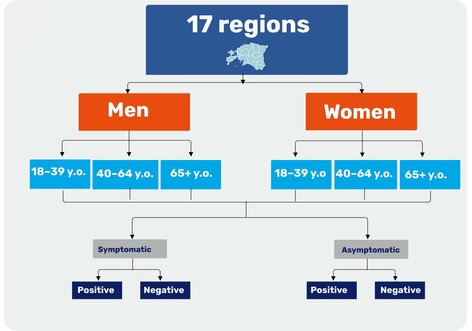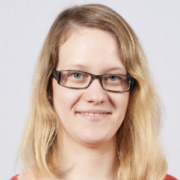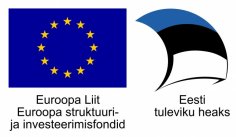
Ruth Kalda
Professor of Family Medicine
In a cross-sectional study, the researchers of the University of Tartu ascertain the actual prevalence of the coronavirus and the progress of the epidemic in Estonia. Based on a random statistical sample, people are interviewed and tested across Estonia to give the state evidence-based data for making decisions about the measures to curb the spread of the virus.
After each survey wave, the research team presents the government interim conclusions that form the basis for evaluating the efficacy of the anti-COVID-19 measures and amending them.
The prevalence of the coronavirus is determined among both the symptomatic and asymptomatic population. This makes it possible to estimate the state-wide spread of the virus in different population groups and regions. The prevalence study reveals the main background characteristics and risk factors of infection (e.g. underlying diseases, size of household, socioeconomic status, types of contact, etc.) and how they relate to the prevalence of the coronavirus. The long-term study helps to follow the change of the number and share of people infected over time and evaluate what factors it is related to. From February 2021, the presence of coronavirus antibodies is also determined among the adult population.
The participation in the study is voluntary; people who have become part of the sample can refuse to be interviewed and/or tested at any moment. The interviewing of the people included in the first wave began on 23 April 2020. The study will continue throughout 2021. Each survey wave lasts for two weeks.
The prevalence survey uses a random stratified sample. It aims to obtain a random sample that is representative of the population strata defined. The survey has 102 population strata (17 regions, 3 age groups and 2 genders, 17 × 3 × 2 = 102).

— the probability of being selected in the sample is not equal between individuals (unless they are in one stratum, as subjects are selected randomly within one stratum);
— the persons selected in the sample represent groups of different sizes within the general population (according to the size of the stratum and the size of the corresponding sub-sample);
— simple arithmetic mean gives a biased estimate for the sub-populations and the general population, so weighted averages should be used according to the size of the strata and the corresponding sub-samples.
If we want to evaluate the efficacy of the measures enacted in the emergency situation and amend the decisions taken thus far in an evidence-based manner, it is important to know the data of the prevalence of the coronavirus among the population. Correct information enables us to select the correct methods."
The panel survey is conducted by the social and market research company AS Emor who gets the information on the people in the sample from the population register. The people who have been included in the sample will be sent an online questionnaire and those who agree to participate in the study will fill it out. The elderly are interviewed over the phone as well, and the interviewer fills out the electronic questionnaire during this. The interviewer calls the study subject, explains the goal of the study and asks whether the person who answered is willing to participate. If the answer is negative, the interview will not be carried out. If the answer is positive, a standardised interview is used.
Both those who answer by phone and those who answer online will be asked about the manifestation of symptoms and important background characteristics, e.g. comorbidities.
Those who have answered the questionnaire will then be contacted by Medicum to arrange the time and location of the testing site where the study participant should go for testing.
The participants will get a link for registration or a call from the Medicum and Synlab testing centres to agree about the suitable time for testing at Synlab testing sites in county centres or in general hospitals. Separate testing points are set up there for those participating in the study. A PCR test from the nasopharynx will be used for testing coronavirus; this shows the existence of the virus RNA in the organism and indicates to an active infection. Antibody testing requires a venous blood sample.
It takes about 10 minutes in total to take both tests. Disabled or elderly people and people with impaired mobility may order a testing team to test them at home.
The analysis of the tests will take place at the Tallinn molecular diagnostics laboratory of SYNLAB, to which the tests will be transported twice a day. The results of the tests will be entered into the Patient Portal and the joint testing call centre of Medicum and SYNLAB will inform the test subjects of the test results.
All those that the study finds to be infected are monitored and interviewed weekly until the end of the disease. If the infected person does not become symptomatic, he or she will be interviewed within two weeks.
The study subjects can be certain that their personal data will be gathered, kept and stored confidentially.
The survey company will get the personal data of the persons in the sample from the population register. The gathering and processing of the data is organized according to the Personal Data Protection Act. The personal and health data of the participants of the study will be gathered in the course of the monitoring programme, and AS Emor and SYNLAB Estonia will forward the data to the University of Tartu in an encrypted form. Only two previously determined members of the University of Tartu research team have the right to decrypt the personal data. The data that would enable to identify a person will be separated from the health data, encoded and kept separately.
The University of Tartu research team will not forward to third persons the data that would enable to identify the participants of the study. The results of the scientific study could be forwarded to other countries for international cooperation. In that case, the data that is sent to other countries will be anonymized, taking into account the rules for protecting personal data in the relevant country.
The Research Ethics Committee of the University of Tartu has approved the study.
About 2,500 people are tested in each survey wave. Survey waves take place every few weeks. The study continues throughout 2021.
The interviewing and testing of the people in the sample, the analysis of the data and the personnel costs of the research team are about 200,000 euros per survey wave. The study is financed by the Estonian government.
- What the actual prevalence of the SARS-CoV-2 infection is among the population, in different population groups (according to age, gender, location and nationality) and among asymptomatic persons. What the number and share of infected persons is.
- What the dynamics of the SARS-CoV-2 prevalence is. How does the number and share of infected persons change over time and what are the factors connected to it.
- What are the main background characteristics and risk factors (comorbidities, size of the household, socioeconomic status, contact types etc.) connected to SARS-CoV-2. How these are connected to prevalence.
- What is the progress of the SARS-CoV-2 infection and the COVID-19 disease (recovery, symptoms, the severity of the disease, hospitalization, death) and how this is connected to the background characteristics and risk factors. Does the progress of the disease change over time.
The study is being prepared and conducted with an involvement of a broad-based collection of University of Tartu researchers, including experts from the University of Tartu Institute of Family Medicine and Public Health, Institute of Genomics, Institute of Computer Science, Institute of Mathematics and Statistics, Johan Skytte Institute of Political Studies.

Ruth Kalda
Professor of Family Medicine

Anneli Uusküla
Professor of Epidemiology

Aime Keis
Junior Lecturer in Medical Ethics

Mikk Jürisson
Research Fellow of Public Health

Mihkel Solvak
Associate Professor of Technology Research

Kristjan Vassil
Associate Professor of Technology Research, Vice-Rector for Research

Lili Milani
Professor of Epi- and Pharmacogenomics
Tuuli Jürgenson
Statistic

Mait Metspalu
Professor of Evolutionary Genomics

Krista Fischer
Professor of Mathematical Statistics, Associate Professor of Biostatistics

Meelis Käärik
Associate Professor in Probability Theory

Liis Kolberg
Junior Research Fellow of Bioinformatics

Hedi Peterson
Associate Professor of Bioinformatics

Jaak Vilo
Professor of Bioinformatics
Uku Raudvere
Scientific Programmer,

Ene-Margit Tiit
Professors emeritus, Faculty of Science and Technology

Since May 2021 the study is funded by the European Regional Development Fund from the EU measure to respond to the Covid-19 pandemic.